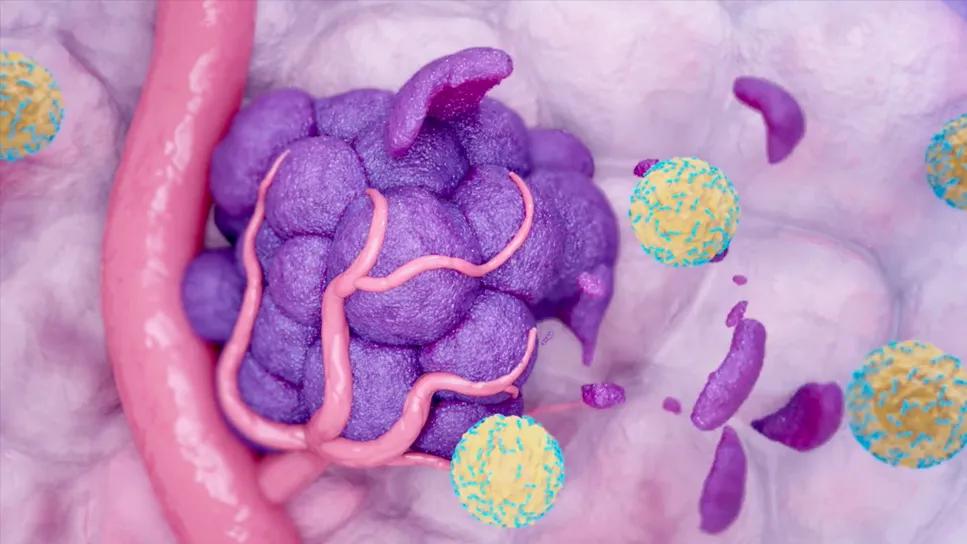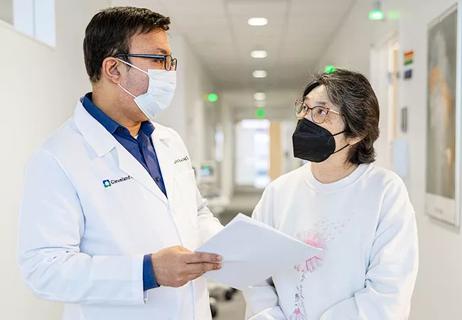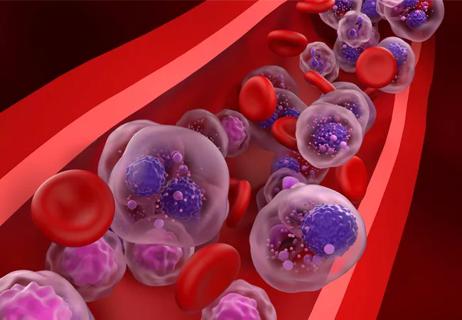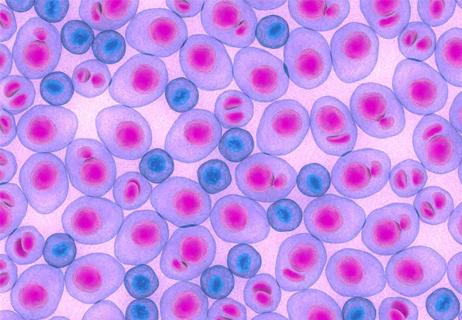Explaining common misconceptions about chimeric antigen receptor therapy

Chimeric antigen receptor (CAR) T-cell therapy emerged several years ago with much fanfare amid clinical trials showing a majority of patients with highly refractory multiple myeloma achieving a clinical response and some achieving complete remission. However, as with any treatment advances, there is sometimes apprehension about what it entails.
Today, ConsultQD had the opportunity to talk with members of Cleveland Clinic Cancer Institute’s Multiple Myeloma team, who debunked many myths about the treatment. Some of the top misconceptions are:
Advertisement
Cleveland Clinic is a non-profit academic medical center. Advertising on our site helps support our mission. We do not endorse non-Cleveland Clinic products or services. Policy
Myth #1: CAR T-cell therapy is a treatment of last resort.
Fact: CAR T-cell therapy can now be used early in the disease trajectory.
“When CAR T-cell therapy first became available, it was being used after patients were penta-refractory and had received four prior regimens, but now CAR T-cell therapy is approved for use after first relapse in the second-line therapy,” explains Faiz Anwer, MD, a Cleveland Clinic oncologist, physician-scientist and cell therapy staff physician. “We expect those patients to do better and hopefully have long-term disease control.”
Cleveland Clinic Cancer Institute is also leading a clinical trial studying the use of CAR T-cell therapy for patients who are newly diagnosed with multiple myeloma.
Myth #2: CAR T-cell therapy requires months in the hospital.
Fact: Prolonged hospitalization is usually not required.
The hospital stay for CAR T-cell therapy is generally 10-14 days. Some patients even have the option for a “hybrid” approach where they are monitored on an outpatient basis for days 1-5 and are only in the hospital from days 6-10 when they’re more likely to experience side effects.
Myth #3: Recovery from CAR T-cell therapy is similar to a stem cell transplant.
Fact: Most patients recover much faster after CAR T-cell therapy.
With CAR T-cell therapy, patients may experience a different set of side effects such as cytokine release syndrome, which can occur when a patient’s immune system goes into ”overdrive.” This can cause fever, chills or confusion. However, the symptoms are usually short-lived and reversible.
“CAR T-cell therapy is generally a gentler treatment than a stem cell transplant, because the chemo we use is not that intense,” says Dr. Anwer. “Usually within four weeks after CAR T-cell therapy, most patients are feeling much better, whereas it can take up to three months or longer to recover back to baseline after a stem cell transplant.”
Advertisement
Myth #4: CAR T-cell therapy is only for younger, fit patients.
Fact: Eligibility guidelines are less stringent for CAR T-cell therapy than they are for a stem cell transplant.
Patients need to be well enough to undergo treatment but that does not mean they need to have an exceptional performance status to qualify. “Even patients who are unfit for a stem cell transplant may potentially be suitable for CAR T-cell therapy,” says Dr. Anwer. “It is important, however, that patients do not have advanced heart failure or renal dysfunction and no active infection.”
Myth #5: CAR T-cell therapy cures multiple myeloma.
Fact: Patients with multiple myeloma can achieve long remissions with CAR T-cell therapy, but it currently is not curative for this disease.
Although CAR T-cell therapy can cure some blood cancers, such as some lymphomas, that isn’t the case with this disease. “Multiple myeloma is highly treatable, but it is not curative at this point,” cautions Dr. Anwer. In clinical studies of penta-refractory patients, the median remission was roughly two years. Clinicians expect that many patients receiving the treatment earlier in their disease course will experience periods of remission that are even longer.
“After therapy, patients are liberated from treatment and from steroid use,” says Director of the Multiple Myeloma team Jason Valent, MD. Patients do need to receive prophylactic anti-infection medications, return for regular checkups and receive updated vaccinations, but during remission they don’t require anti-myeloma medications.
Advertisement
Myth #6: Patients will experience severe side effects.
Fact: Side effects can be serious but are manageable and usually are temporary.
Now that CAR T-cell therapy has been standard of care for several years, there is a greater understanding at academic medical centers about not just the types of side effects but also the timing of when they may occur.
“Our team is specialized at caring for this disease and has well-established protocols for diagnosing and managing side effects of CAR T-cell therapy,” says Dr. Valent. “The overwhelming majority of patients complete therapy without significant side effects. A month later, they’re usually feeling remarkably well.”
Side effect management includes the use of immunoglobins, antivirals and antibacterial medications to stave off infection as well as the administration of Tocilizumab to reverse cytokine release syndrome if it occurs.
“Delayed side effects, mostly related to the central nervous system (what we call neurotoxicity) could occur months down the road, but they are generally rare and we are learning about ways to mitigate them,” says hematologist/oncologist Jack Khouri, MD.
Myth #7: I need to wait until my patient relapses before referring them for CAR T-cell therapy.
Fact: It’s best to refer a patient while they’re still stable.
Currently it takes six weeks to manufacture autologous CAR T-cell products. That’s why time is of the essence when referring a patient. Once a patient with multiple myeloma first relapses, it’s important to have them evaluated for CAR T-cell therapy, based on their physical and their disease characteristics.
Today, the CAR T-cell therapy process involves:
• Conducting a detailed screening, including assessing organ function and performing a bone marrow biopsy
• Collecting the patient’s T cells and shipping them to the manufacturer
• Waiting for the cells to be engineered by the manufacturer
• Receiving the cells back
• Having the patient undergo lymphodepleting chemotherapy to help the engineered cells persist in their body
• Reinfusing the engineered cells into the patient
• Monitoring the patient for side effects
Cleveland Clinic Cancer Institute is also studying the use of off-the-shelf allogenic CAR T-cell products that potentially could be available in less than two weeks. This is one of many cell therapy trials underway.
With all the swift advances in myeloma therapies, deciding the sequence of when to initiative cell therapy is challenging. The clinic’s team of myeloma experts specializes in cell therapies and clinical trials, performing roughly 80 CAR T-cell therapies a year. “We’re here to help,” says Dr. Anwer. “Even if a patient isn’t eligible for CAR T-cell therapy, we can advise their oncologist on the best next line of therapy for them.”
Advertisement
Myth #8: Patients need maintenance therapy after CAR T-cell therapy as with stem cell transplant.
Fact: No maintenance therapy is needed.
After patients receive CAR T-cell therapy, they do not go on a specific treatment to maintain remission as is done with stem cell transplant. “Patients feel better overall from a quality of life perspective due to being off treatment,” says Dr. Khouri. “They also come less to the infusion center with less time off from work and more free time away from the hospital.”
Advertisement
Advertisement

Phase 2 study brings pivotal advances in treatment efficacy and safety for the most challenging-to-treat population

Making sense of the fast-moving treatment landscape

Clinicians share practices to streamline initiation of care

Prediction and bioinformatic data could prove valuable for therapeutic interventions targeting this malignancy

Findings from large database important to inform clinical practice

Study of 401,576 patients reveals differences in cancer burdens as well as overall survival

Despite sicker patients, response rates of teclistamab in a real-world study were similar to those from a pivotal clinical trial

Strategies and risk models are evolving for this asymptomatic condition